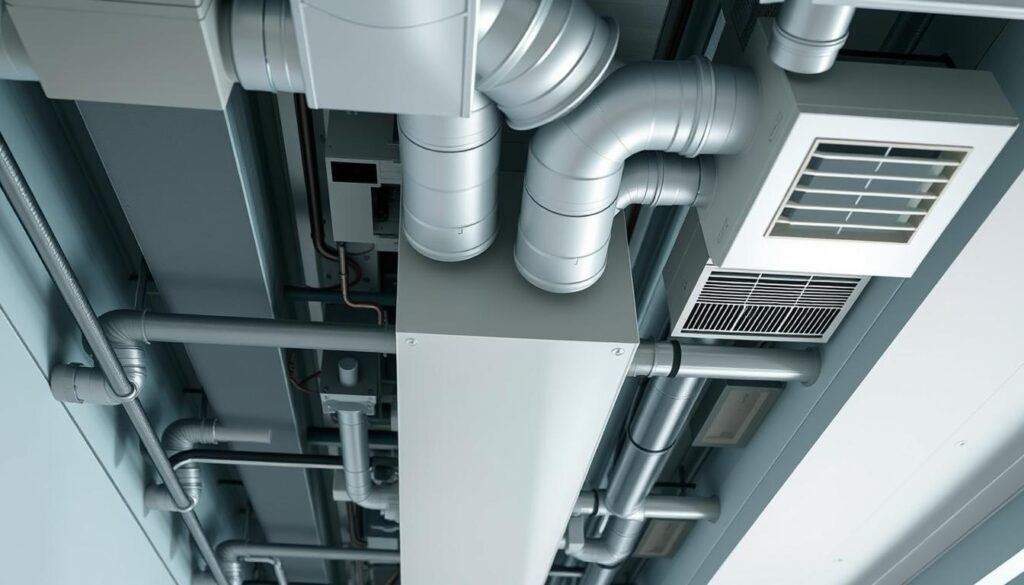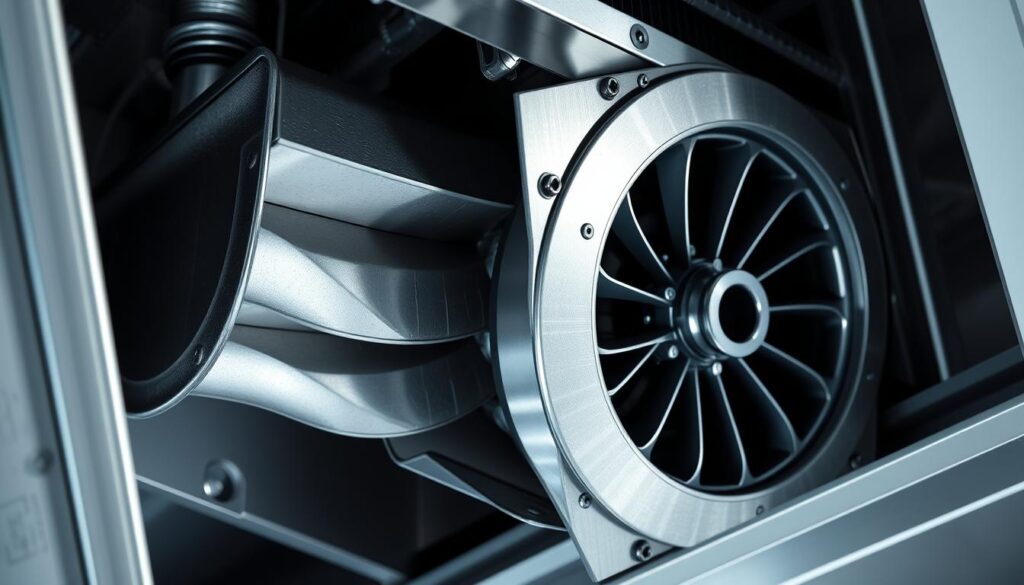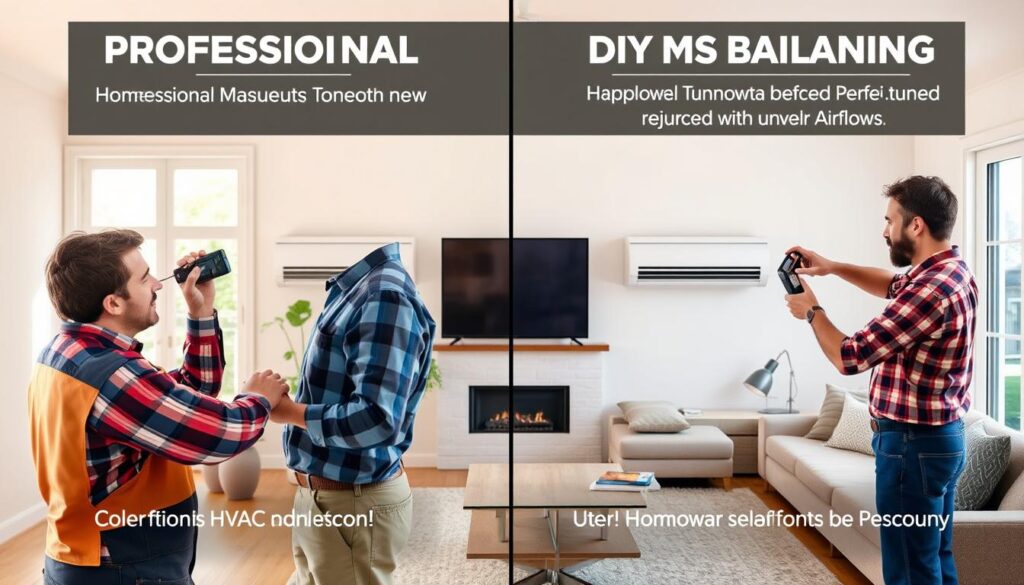Affiliate Disclosure
HVAC Guide Guys is a participant in the Amazon Services LLC Associates Program, an affiliate advertising program designed to provide a means for sites to earn advertising fees by advertising and linking to Amazon.
How to Balance a Home HVAC System? Are you tired of walking from a freezing bedroom to a sweltering living room in your own home? What if you could create perfect temperature harmony throughout every room without expensive upgrades?

Learning how to balance a home HVAC system is the key to transforming your indoor comfort. Air distribution isn’t just about moving air—it’s about creating a consistent, comfortable environment. This keeps every space in your home at the ideal temperature.
This comprehensive guide will walk you through the essential steps to improve home air distribution. From understanding basic HVAC mechanics to practical adjustment techniques, you’ll discover how to optimize your system’s performance. You’ll learn how to eliminate those frustrating temperature variations.
Key Takeaways
- Understand the fundamentals of HVAC air balancing
- Learn to diagnose uneven temperature distribution
- Discover tools and techniques for system optimization
- Recognize signs of an unbalanced HVAC system
- Save energy and improve home comfort
Table of Contents
Understanding HVAC Air Balancing Basics
Keeping your home at a consistent temperature is key for comfort and saving energy. Balancing your HVAC ductwork helps make sure every room is just right.
What is Air Balancing?
Air balancing is a precise method to adjust your home’s heating and cooling. It ensures each room gets the right amount of air. This creates a harmonious temperature environment in your home.
Why Balance Your HVAC System?
- Eliminate temperature variations between rooms
- Reduce energy consumption
- Improve overall system performance
- Extend HVAC equipment lifespan
Signs of an Unbalanced System
Knowing when your HVAC system needs balancing is important. Look out for these signs:
- Significant temperature differences between rooms
- Rooms that feel stuffy or drafty
- Inconsistent airflow from vents
- Higher than normal energy bills
Proper balancing of HVAC ductwork ensures even temperatures in your home. This boosts both comfort and energy efficiency.
Essential Tools and Equipment for Air Balancing
To master diy hvac balancing, you need the right tools. These tools help ensure your hvac system works well. Both pros and DIY folks use special gear to check and tweak airflow in your home’s heating and cooling.
- Anemometer: A precision instrument that measures air velocity and volume directly at ventilation points
- Digital Thermometer: Helps track temperature variations across different rooms and registers
- Manometer: Measures static pressure within ductwork to identify potential airflow restrictions
- Flow Hood: Professional-grade device for comprehensive airflow measurement
When picking tools for diy hvac balancing, go for quality digital ones. Getting accurate readings is key to spotting and fixing airflow issues. These issues can hurt your hvac system’s performance.
Homeowners can find affordable tools for basic air balancing. Infrared thermometers and handheld anemometers work well for initial checks. But, if you want more precise data, you’ll need to spend more on professional tools.
Tip: Rent professional tools from local hardware stores if you’re uncomfortable making a significant investment.
Explore Our HVAC Shop
Looking for top-rated HVAC tools, parts, and accessories? Visit our shop and find the perfect solution for your needs.
Visit the ShopHow to Balance a Home HVAC System
Balancing your home HVAC system is key for comfort and saving energy. It makes sure each room gets the right air, avoiding hot and cold spots.
To balance your HVAC system, follow a step-by-step guide. It involves checking and adjusting things carefully. With the right tools and knowledge, you can make your home more comfortable.
Initial System Assessment
Start by checking your HVAC system thoroughly. Look at these important parts:
- Make sure all volume dampers are open
- Check that fan speeds are correct
- Look for any damage or blockages in ductwork
- Ensure air filters are clean and free
Measuring Current Airflow
Getting accurate airflow measurements is crucial. Use special tools to check your system’s performance:
- Use an anemometer to measure air speed at vents
- Take static pressure readings
- Compare airflow with design specs
Making Preliminary Adjustments
After measuring, make adjustments to improve air flow. You might need to:
- Move dampers in ductwork
- Change fan speed settings
- Clear air register obstructions
- Seal air leaks in ductwork
Pro Tip: Balancing your HVAC system takes patience. Small changes often work best.
Getting perfect air balance needs attention to detail and a careful plan. If you face ongoing issues, an HVAC expert can help.
Understanding Dampers and Vents

Dampers and vents are vital for balancing your home’s heating and cooling. They control airflow, ensuring even temperatures and energy savings.
Dampers are like valves in your HVAC ducts. They have handles that let you adjust airflow. By adjusting these, you can make sure your home’s temperature is just right.
- Dampers are located inside ductwork
- They can be manually adjusted to control air volume
- Critical for balancing heating and cooling system performance
Vents are the parts of your HVAC system you can see. They’re on walls or floors and have adjustable louvers. Adjusting vents can greatly improve your home’s comfort.
“Proper damper and vent management is the key to a perfectly balanced home climate.” – HVAC Expert
Knowing how to use dampers and vents is key to even temperatures. It’s especially important in homes with different levels or rooms with different sun exposure. Adjusting these can make your home more comfortable.
Explore Our HVAC Shop
Looking for top-rated HVAC tools, parts, and accessories? Visit our shop and find the perfect solution for your needs.
Visit the ShopStep-by-Step Air Balancing Procedure
Getting your home to feel just right means paying attention to your HVAC system. You can use DIY methods to make your air flow better. This makes your home more comfortable to live in.
Learning to balance your home’s air is a useful skill. It can save you money and make your home more cozy. You can do it yourself with some basic knowledge and tools.
Locating and Mapping Ductwork
First, find and map out your home’s ductwork system. Start with your central heating and cooling unit. Then, trace every duct in your home. Look closely at:
- Main trunk lines
- Branch ducts
- Existing damper locations
- Vent and register positions
Testing Airflow at Vents
Measuring air flow is key to balancing your HVAC system. Here’s how to check each room’s air:
- Paper Test: Hold a lightweight paper near each vent to see how strong the air is
- Use an anemometer for exact measurements
- Compare air flow in different rooms
Adjusting Damper Positions
Adjusting your system’s dampers lets you control air flow. Make small changes to the dampers to get the air right in each room.
Pro Tip: Small adjustments can make a big difference in your home’s comfort.
Using these DIY methods can greatly improve your home’s air flow. This makes your home a more comfortable place to live.
Common Air Balancing Challenges
Getting your HVAC system to work efficiently can be hard. Homeowners face many challenges when trying to balance their home’s air. Knowing these issues is key to making your home more comfortable.
The main air balancing problems include:
- Insufficient Total Airflow: This is often due to:
- Clogged air filters
- Ductwork that’s too small
- Blocked return air vents
- Room Temperature Variations: Some spots stay too hot or cold, even after adjusting
- Increased System Noise After Balancing
- Pressure Imbalances Between Different Rooms
“Proper air balancing transforms your HVAC system from merely functional to genuinely comfortable.” – HVAC Professional
To solve these problems, start by checking your ductwork for blockages. Make sure all dampers are in the right place. Also, check that vents aren’t blocked by furniture or curtains.
Experts say regular system checks are important for keeping your home comfortable. By tackling these issues early, you can make your HVAC system more efficient. This will help make your home a more comfortable place to live.
Explore Our HVAC Shop
Looking for top-rated HVAC tools, parts, and accessories? Visit our shop and find the perfect solution for your needs.
Visit the ShopOptimizing Room Temperature Distribution
Keeping your house at an even temperature is key for comfort. If some rooms are too hot or cold, it affects your whole experience. This can make some areas feel uncomfortable while others are just right.
Often, uneven temperatures come from design issues and system problems. If rooms differ by more than 2-3 degrees, it’s time to adjust your HVAC.
Addressing Hot and Cold Spots
Finding out why some rooms are too hot or cold takes some work. Look at your home’s layout and how it’s set up. Here are some tips to fix these problems:
- Check window insulation and seal air leaks
- Look for blockages in ductwork
- Make sure vents are in the right spots
- Think about using fans to move air
Managing Multi-Level Home Challenges
Multi-level homes face special challenges with temperature. Heat goes up, so floors can feel different.
| Floor Level | Typical Temperature Difference | Recommended Solution |
|---|---|---|
| Ground Floor | Cooler | Adjust register openings |
| Upper Floor | Warmer | Increase air return capacity |
| Basement | Most Stable | Minimal intervention required |
With these strategies, you can make your home’s temperature more even. This will make your living space more comfortable.
Professional vs DIY Air Balancing

Choosing between professional and DIY hvac balancing can be tough for homeowners. Both methods have their own benefits and drawbacks. They affect your home’s comfort and how much energy it uses.
Professional HVAC technicians have the skills and tools needed for air balancing. They do a thorough job that includes:
- Precise airflow measurements at each vent
- Comprehensive system diagnostic analysis
- Detailed evaluation of ductwork and equipment
The cost of hiring a pro varies. Most charge around $100 per vent or opening. Even though it’s pricey, pros can find problems DIY methods might miss.
| Professional Service | DIY Approach |
|---|---|
| Specialized diagnostic equipment | Basic home tools |
| Comprehensive system analysis | Limited diagnostic capabilities |
| Guaranteed results | Variable outcomes |
DIY balancing can save you money if you’re handy. It lets you learn about your HVAC system. Go for DIY if you’re okay with basic measurements and tweaks.
Tip: Always assess your technical comfort level before attempting DIY HVAC balancing.
What’s best for you depends on your system, skills, and budget. Some might mix DIY and pro help. DIY for simple tasks, then call a pro for tough problems.
Maintaining Balanced Airflow Year-Round
To keep your HVAC system running well all year, you need a good plan and regular upkeep. The seasons change, and so does how your HVAC works. It’s key to adjust your home comfort plan often.
Your HVAC system changes with the seasons. It needs special care in summer and winter to work its best. Knowing these changes helps you stay ahead with your maintenance.
Seasonal Adjustment Tips
- Summer: Reduce airflow resistance by cleaning air filters monthly
- Winter: Check and seal duct connections to prevent heat loss
- Spring/Fall: Inspect outdoor unit for debris and vegetation growth
- Adjust thermostat settings to match seasonal temperature changes
Regular Maintenance Checklist
| Maintenance Task | Frequency | Purpose |
|---|---|---|
| Replace Air Filters | Every 1-3 months | Improve air quality and system efficiency |
| Clean Air Vents | Quarterly | Prevent dust buildup and blockages |
| Professional Inspection | Annually | Comprehensive system health check |
Follow these tips to keep your home comfortable all year. You’ll also make your HVAC system more efficient.
Explore Our HVAC Shop
Looking for top-rated HVAC tools, parts, and accessories? Visit our shop and find the perfect solution for your needs.
Visit the ShopTroubleshooting Balance Issues
Keeping your home’s air evenly distributed can be tough. Even after you’ve balanced your HVAC system, problems might still arise. Spotting and fixing these issues fast can make your home’s air flow better and keep it comfortable.
To fix air flow problems in your HVAC, start with a detailed system check. Look for signs that might mess with your home’s air balance:
- Blocked or restricted supply vents
- Damaged or crushed ductwork
- Furniture obstructing air circulation
- Improperly positioned dampers
Focus on these key areas:
| Problem Area | Potential Solution |
|---|---|
| Closed Dampers | Reopen and adjust damper positions |
| Damaged Ductwork | Repair or replace flexible ducts |
| Blocked Vents | Clear obstructions and rearrange furniture |
If you still have uneven temperatures, think about adding extra dampers. HVAC experts can find and fix complex air flow issues. They’ll suggest the best fixes for your home’s layout.
Pro Tip: Regular system maintenance and airflow checks can stop many balance problems before they get big.
Conclusion
Learning to balance your home’s HVAC system is more than a skill. It’s a way to make your home comfortable and energy-efficient. By using the tips from this guide, you can improve your home’s heating and cooling. This ensures each room has the right airflow and temperature.
HVAC system efficiency is about more than just being comfortable. It’s about managing your home smartly. The air balancing techniques you’ve learned can cut down on energy use. This means lower bills and a longer life for your HVAC equipment.
Regular upkeep and checks on your HVAC system are key. They help keep the balance you’ve achieved. You can do this yourself or get help from a pro. Either way, you’ll be able to make better choices for your home’s climate control.
A well-balanced HVAC system is an ongoing effort. Stay on top of your system’s performance and adjust as needed. Your dedication to your HVAC system will bring you comfort, efficiency, and peace of mind.

